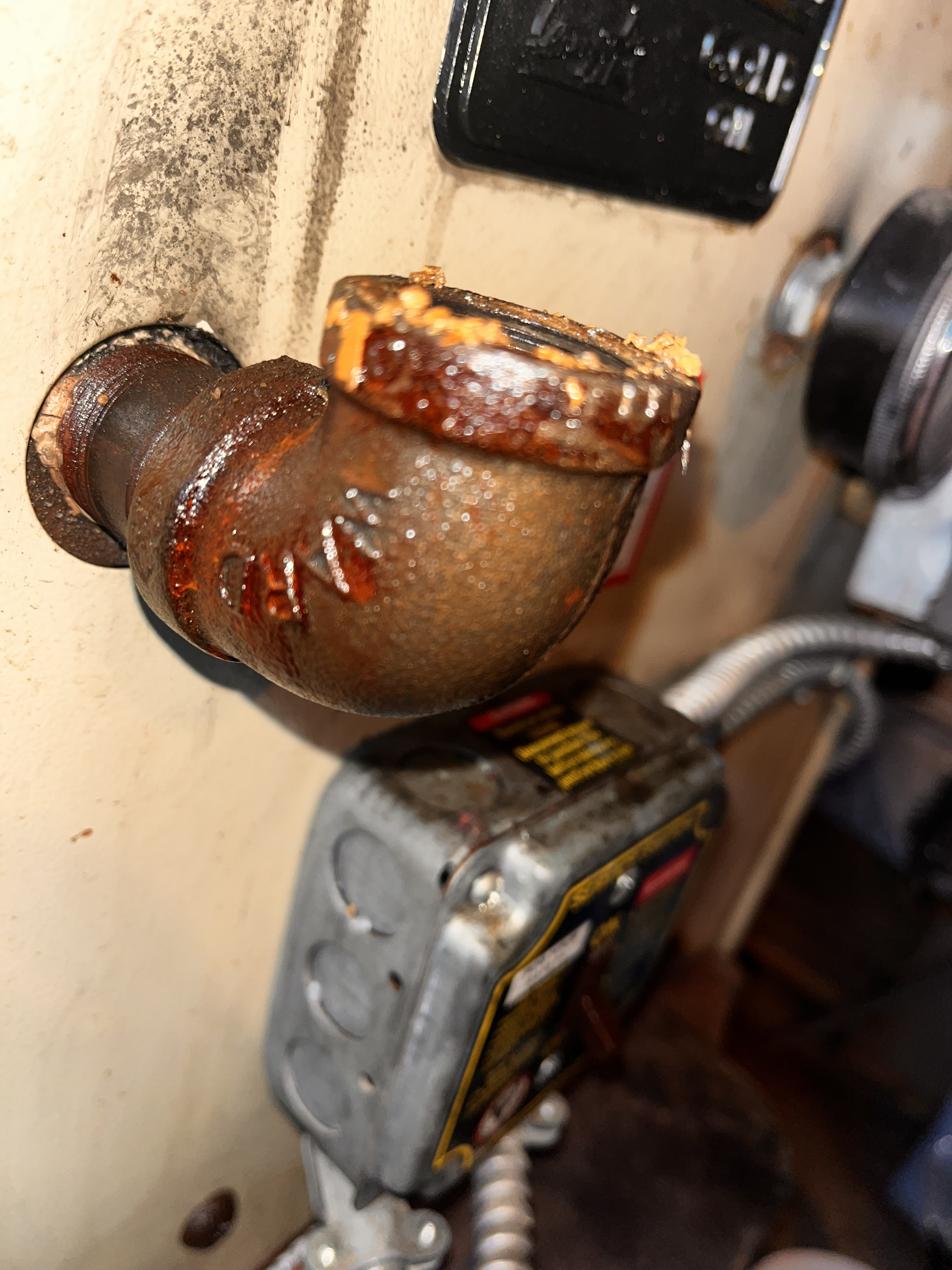Copper or black iron at relief valve
Putting in new brass relief valve, what of the piping should be black iron and what copper/brass?
How do you tell whether an old pipe is iron or copper/brass?
I have to buy a new nipple anyway because it broke right off when I tried to wrench it out of the old valve - maybe it was iron into brass and corrosion weakened it? Should I make the outlet side brass nipple to brass elbow to copper drop pipe? Can I leave the allegedly iron elbow at the boiler to contact the brass valve? What would you do?



Comments
-
A magnet will tell you, but everything there except the tube in your hand and the male adapter soldered to it, and the pressure relief is steel.
Single pipe 392sqft system with an EG-40 rated for 325sqft and it's silent and balanced at all times.
0 -
What I thought. So, switch them to brass or get iron? Iron elbow at boiler okay to go onto brass valve?0
-
In a perfect world the nipple and elbow coming out of the boiler should be brass. The manufacturer uses steel so steel it is. So, we are going from cast iron (boiler) to steel nipple & 90 to brass the pressure relief valve. The most important thing is that the discharge of the pressure relief valve is piped copper or brass to avoid corrosion. Most codes state a non-ferrous discharge pipe must be used.0
-
CTETeach said:In a perfect world the nipple and elbow coming out of the boiler should be brass. The manufacturer uses steel so steel it is. So, we are going from cast iron (boiler) to steel nipple & 90 to brass the pressure relief valve. The most important thing is that the discharge of the pressure relief valve is piped copper or brass to avoid corrosion. Most codes state a non-ferrous discharge pipe must be used.
0 -
-
I will except I think I’ll leave the steel elbow at the boiler so I don’t have to mess with it. And I figure if there will be galvanization let it be between elbow and valve rather than right at the boiler itself, though I don’t know if that’s a removable nipple on the boiler side of the elbow or some integral part of the boiler (if I were a pro like you guys I’d know, but such is the burden of ignorance).0
-
So to follow the "perfect world" analogy, should the cast iron boiler also be brass? Or should we just use steel/iron relief valves? Then what would I do with all these copper to male adaptors I have in my shop? I guess we will never see a "perfect world". All you need to do is look at Washington DC and you will know there is no chance for a "perfect world"CTETeach said:In a perfect world the nipple and elbow coming out of the boiler should be brass. The manufacturer uses steel so steel it is. So, we are going from cast iron (boiler) to steel nipple & 90 to brass the pressure relief valve. The most important thing is that the discharge of the pressure relief valve is piped copper or brass to avoid corrosion. Most codes state a non-ferrous discharge pipe must be used.
@seized123, your queries never cease to amaze me. I guess I have been in this trade too many years now. I cant remember a time when I didn't know the difference between a copper fitting or pipe and a steel or iron fitting or pipe. I do know that the silver ones are probably Galvanized and the black or rusty ones are Black Iron. But how they make them galvanized and how galvanizing reduces the amount of rust that happens on what seems to be otherwise identical fittings was never explained to me, and I didn't care to know. You see, to know what time it is, I look at a clock, I don't try to build a clock.
So my question to you is, Why do you need to know?Edward Young Retired
After you make that expensive repair and you still have the same problem, What will you check next?
1 -
Id consider these dry connections, so the blend of dis similar fittings should not cause corrosion or electrolysis
Tank water heaters always have brass T&P valves into a steel tank, as do boilers
I don’t recall a code stating non ferrous relief tubes?
I do recall old codes stating metallic tubes, but I see water heaters with plastic relief tubes nowBob "hot rod" Rohr
trainer for Caleffi NA
Living the hydronic dream0 -
Either are fine. I have had both pass inspection.
Edward Young Retired
After you make that expensive repair and you still have the same problem, What will you check next?
0 -
The inspector in my area wants copper or brass.
Is it code? No.Single pipe 392sqft system with an EG-40 rated for 325sqft and it's silent and balanced at all times.
0 -
Thanks for all the comments. I put in all brass after the presumably iron elbow out of the boiler, then the old copper relief tube, hope that turns out okay.0
Categories
- All Categories
- 87.3K THE MAIN WALL
- 3.2K A-C, Heat Pumps & Refrigeration
- 61 Biomass
- 429 Carbon Monoxide Awareness
- 120 Chimneys & Flues
- 2.1K Domestic Hot Water
- 5.8K Gas Heating
- 115 Geothermal
- 166 Indoor-Air Quality
- 3.7K Oil Heating
- 77 Pipe Deterioration
- 1K Plumbing
- 6.5K Radiant Heating
- 395 Solar
- 15.7K Strictly Steam
- 3.4K Thermostats and Controls
- 56 Water Quality
- 51 Industry Classes
- 50 Job Opportunities
- 18 Recall Announcements




